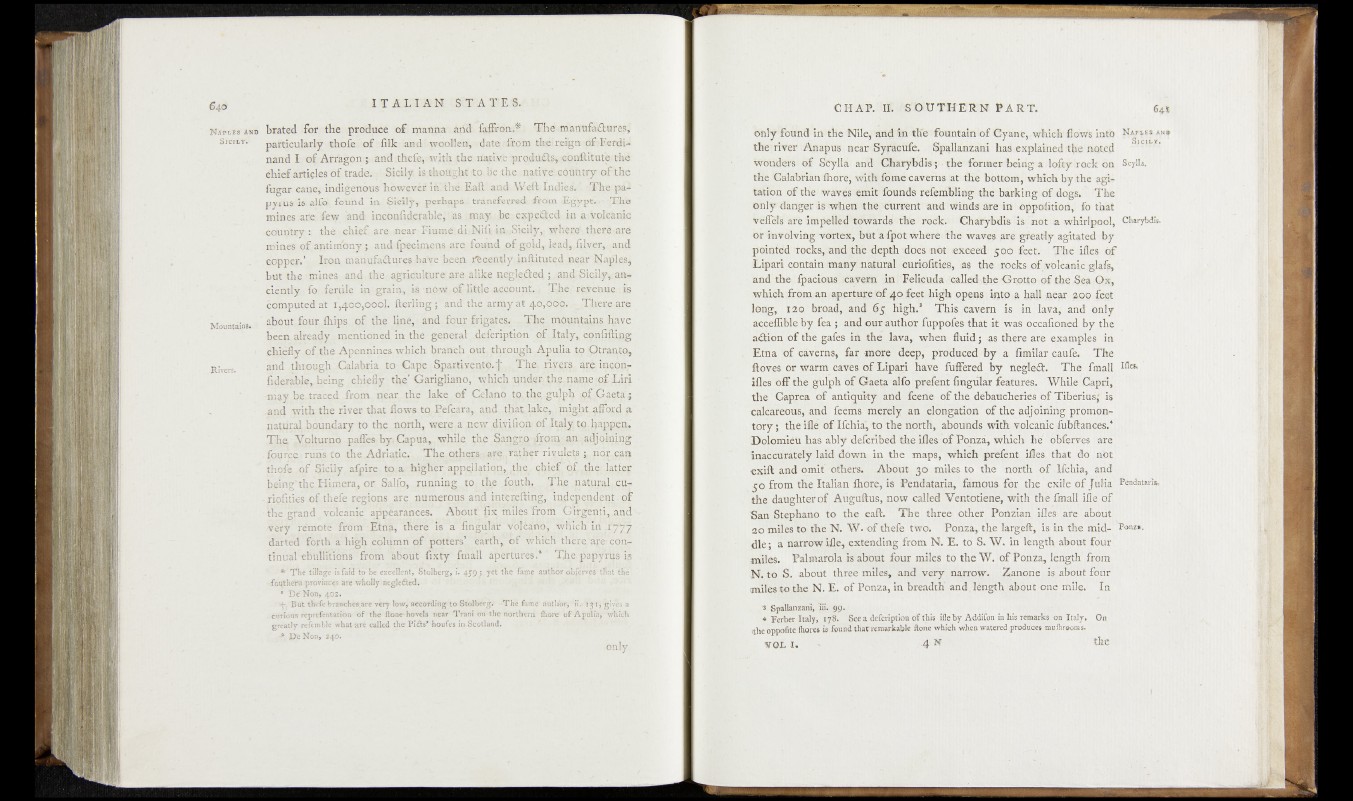
6 4 0 I T AL IM , S T A T E S.
N a p le s And
SlCi'L'Y. ’
Mountains.
Hivers.
brated for the produce of manna. hhft fafïron.* ^hé;C0uadQfefl.ar^
particularly th o f e of filk a n d : woollen, date^from tkèîre%a-.pf.:Ferdinand
I of Arragon-; and thefe, .with the ntatïyfe:produ âs,i@pnftitut 1 çt]m
chief articles of trade. Sicily is thought -to, be the nativeieouhtry o f 'thé
fogar cane, indigenous however in thé Eaft ..and Weft - ïndièsy The papyrus'is
alfo ; found in Sicily,; perhaps transferred- from Egypt. . The
mines.are. few and inconfidefable^tiàs.ntôay be è x p 'â e d in a volcanic
• country : the I chief are near Fiume. di Niii in Sicily, where there tare
mines of antimony ; and fpecimens are found of gold, Jead.,,filver, and
.copper.1 Ironlmanufaànres have been recently inftituted.near Napîgsj.
but the mines .and the agriculture; aSeralike neglected ; and Sicily, anciently
fo fertile in grain, is now of little .account. T h e ; rèyénj|e jis
computed at 1,400,000b fterling ; and the army at 40,000. There are
about four fliips of the line, and four frigate^ The mountains havê-
been already mentioned in the--general defcription of Italy, Confiding
chiefly of the Apennines which branch out through Apulia to Otranto,
and through Calabria to Gape Spar-tiveato.J. The. rivers,, are incori-
fiderable, being chiefly the' Garigliano, which under the. name; of Liri
•may be traced from near the lake of Cêlanb to the gulph of Gaeta;;
and with the river that flows to Pefcara, and that lake,, .might afford a
natural boundary to the north, were.a.new divifionçpf Italy to.happen.
T h e y pltumo paffes by, Capua, while the Sangr/pytfrorp an adjoining
fource • runs to the Adriatic. The others- are..,rather rivulets ;; nor can
thofe of Sicily afpire to a higher appellation, 100. chief of the; latfer
being'the Himera, o r Salfo, running to the .fouth. The natural cu~
- riofities of thefe regions are numerous, and interefting, independent of
•the grand volcanic appearances. About, fix miles from Girgentij,. and
-very remote from JEtni, there is a fingular volcano, which', in .1777
darted forth a high column o f potters’, "earth, of which there are con-
tinual ehulfitions from ahout fixty fmall apertures.1 The. papyrus is
■ * T h e tillage is laid to"be. excellent, Stolberg, i. 459 4 y e t the fame author.obfervçl"{nat thé
fotjtliern provinces are wholly; neglected; :
1 De Non, 402.
. 4 . B u t th'efe bmn'chës;àre very low, according to Stolberg. T h é famé’ aMhtàïÿ^b I yi-j 'gives a
.. curious- reprefentation o f the Itone-hovela near Trani on th e northern ffiorè’- o f Apulia^ which
greatly referable what are called the .Pitts’ houfes in .Scotland.
I §jg Dfe Non, 24m
.only
CHAP. II. SOUTHERN PART. €41
hfely 'ibnnSdhThef^ilej’SMd fc tHe-fbttniCatniof Cykn6,rwhi<&'flow's inti) JlAKfcB am
the' river AnapuS- near Sypâoùfe. Spallanzani has explained jH|j$ noted
%'fefadfei’S'ëf §Kyfia-and Gharÿb:& ';’-''the former being a lofty rack
the Calabrian fhore, wath feme caverns at the bottom, which by the agir
tatron of A?e-Aivk*ve's emirifounds refembliog the bkife®g;.ofi dsogs.' ’ 'This
tenly:-danger Is -when thebun^nt and winds' aare in1 ©ppsfkioa, fo that
Vhiels are impelled towards thte ' whirlpool, CKaryM».
or’lnfcl¥i&gT«fot*et, bit kfpot, whereThe waves are giieatiy abated by
•pointed locks, And the depth does «ert texeeed 5^0' £eet. The ifles of
Idpari contain many neural tburkdaliies, as the iipx^scdfjybl-cdTitP.'g^4fe
and the fpaciaiis ‘cayer-n in ;‘Telismda :c&fl^-4he/0rja^p^f the §ea.Qx,
which from an aperture erf 40 feet.high opens i#jtp.;a hjall near 000 feet
long, 120 broad, ancf 6 c High.1 This cavern is in lava, .and' only
acceflible. Bp fea ; and our author fuppofes that it'jwas;'dCjGam^&:by the
a&ion of the gafes^ in the lava, when fluid.,; as th e^ aie examples in
Etna 'of caverns, far more deep, produced by a fihnlaucaidp.- The
ftoves or warm caves of Lipari have fufiered by negleT.M}Tb!^ fmall
ifles off the gulph of Gaeta alfo .prefent fingular features. While Capri,
the Caprea of antiquity and feene of the. debaucheries of Tiheriùsf is
calcareous, and feems' merely an, „elongation of tSe^ajoining promontory
; tfle ifle of lfchia^ tq the north, abounds with volcanic •fixh.ftances.4 ;
Dolomièu has ably deferibèd the ifles of Ponza, which he *obferves are ,
inaccurately laid down in the mapsj which prefent ifles Mat do nbt
cxift and omit others. About 30 ; miles tothe north of JLfchia, and
50 from the Italian fhore, is Pendataria, famous for the, exilé '@f Julia Pendatarix
the daughter of Auguftus, now called Ventotiene, with the fmall ifle.of‘T
San Stephaiio to the eaft. The three other Ponztàn' îfle|<taFe ,ab®ûf
26 miles to the N. W. of thefe tVoi Ponza, the largeft, i&Wflie mi^- P<»u*.
die* a narrow ifle, extending from N. E. to S. W. in length about1 foif*
,miles» Pàlmarola is about four miles to the W. of Ponza, length from
N. to S. about three miles, and very narrow, ^anorie^is^âhbut fouf
miles to the N. E. of Ponza, in breadth and, léngfh about one mile. In
3 Spallanzani, iii. 99.
* Ferber Italy, 178. See a defcription oTthis ifle b y Addiwn mnia remarks, on Italy. On
itbe oppofite Ihores 13 found that remarkable ftone which when watered .produce» inufcreoms. ’
vo x i. ' É 3 the
m